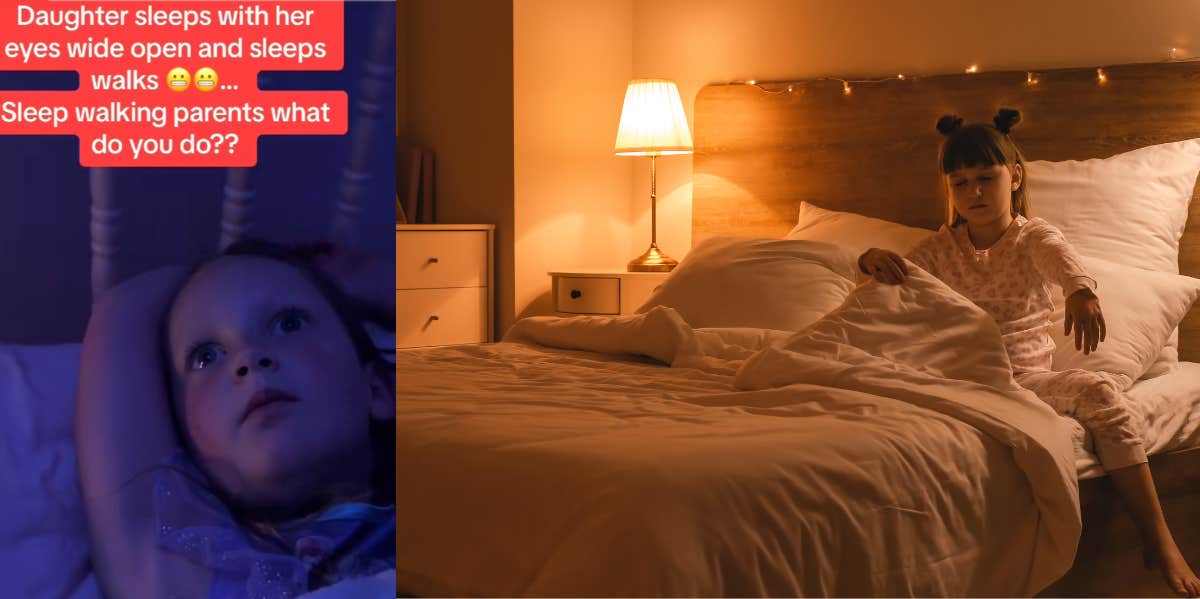Mom Shares Video Of Her Daughter Sleeping With Her Eyes Wide Open & Asks For Help — 'She Sleepwalks Like This'
Sleeping with open eyes is actually more common than you'd think.
 @arielgracephotography / TikTok & Pixel-Shot / Shutterstock
@arielgracephotography / TikTok & Pixel-Shot / Shutterstock According to WebMD, 20% of people of all ages, including babies, sleep with their eyes open. This condition is called nocturnal lagophthalmos, and those who have it can typically close their eyes most of the way — but that is certainly not the case for TikTok user Ariel Grace’s daughter.
The mom posted a video of her daughter sleeping with her eyes wide open as if out of fright.
In the video, as her daughter lays in bed fast asleep with her eyes wide open, Ariel waves her hand in front of her daughter’s face repeatedly — but she doesn’t blink or budge.
"Daughter sleeps with her eyes wide open and sleep walks," the mom wrote on the video.
Users in the comments suggested the TikTok user use locks on her doors.
Most users who suggested this said they also sleepwalked when they were children and locks helped them. One user wrote that they ran away from home at two years old because they were sleepwalking, so their parents put a lock on their door to prevent this from happening again. Another user said that they almost walked off of a dock when they were little because of sleepwalking, so their parents put a lock above their door so they couldn’t reach it and unlock it in their sleep.
Other users mentioned putting alarms on the doors and windows so that when Ariel’s daughter sleepwalks, it alerts everyone in the house.
Some users in the comments suggested that Ariel get a sleep study done on her daughter. One user mentioned that they used to sleep with their eyes open and got tested for sleep apnea. They received treatment and no longer sleep like this. Another shared that her son used to do this before being treated for sleep apnea as well.
Experts say sleeping with your eyes open can be easily treated.
About one-third of children sleepwalk at some point or another, according to the Royal Children’s Hospital of Melbourne. It is most commonly seen between the ages of two through eight.
Children sleepwalk because they are stuck between being awake and asleep.
“A few hours after falling asleep, children move from a deep sleep to light sleep. It is at this stage your child can get stuck. They wake up enough to get out of bed, talk and have their eyes open but they are asleep in that they do not respond to you trying to interact with them.”
According to the American Academy of Ophthalmology, taking precautions for sleeping with your eyes open is not necessary, however, "an eye exam is required to make sure the eyes are sufficiently moist so that the cornea is not being damaged." It is advised to get a humidifier to keep the air in the room from drying out and to put eye drops in the eyes before falling asleep.
Doctors at the Royal Children’s Melbourne Hospital recommend redirecting the child back to bed if they are caught sleepwalking.
They also say to keep the house safe and secure by locking the doors and windows. Another tip that they mention is to not make a big deal out of their sleepwalking the next day because it might make the child too anxious to go to bed the next night.
When should medical help be sought out?
Doctors at the Royal Children’s Melbourne Hospital recommend seeking out medical help if the sleepwalking is causing the child to be very tired during the day. They also say that it is concerning if their sleepwalking is associated with loud snoring or gasping for breath. A third sign to be concerned about is if your child is wetting themselves during a sleepwalking episode.
Most children grow out of sleepwalking and sleeping with their eyes open, so hopefully for Ariel’s daughter, this is just a phase that she will grow out of too. We hope this is helpful to Ariel Grace if she ever sees it and is helpful to any other parent who is dealing with a child who sleepwalks or sleeps with their eyes open.
Tarah Hickel is a Washington-based writer and a frequent contributor to YourTango. She focuses on entertainment and news stories including human interest pieces.
